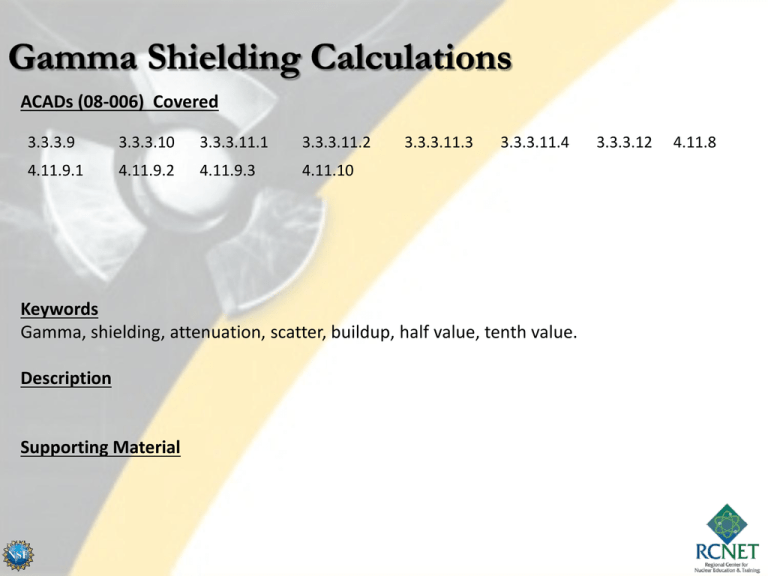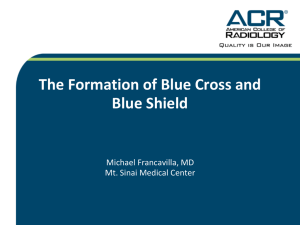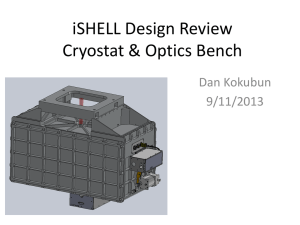Gamma Shielding Calculations
advertisement

ACADs (08-006) Covered 3.3.3.9 3.3.3.10 3.3.3.11.1 3.3.3.11.2 4.11.9.1 4.11.9.2 4.11.9.3 4.11.10 3.3.3.11.3 3.3.3.11.4 Keywords Gamma, shielding, attenuation, scatter, buildup, half value, tenth value. Description Supporting Material 3.3.3.12 4.11.8 Gamma Shielding Calculations Radiation Protection III NUCP2331 SHIELDING • Gamma Radiation – Gamma rays do not give up energy continuously as charged particles do – Gamma ray intensity decreases due to absorption or scattering – Efficiency of the shield depends upon the probability of interaction and thickness of material – Attenuation-Process by which radiation is reduced in intensity when passing through some material Attenuation Coefficients • l (cm-1) Linear Absorption Coefficient is defined as the probability of interaction per unit path length of material • m (cm2/g) Mass Absorption Coefficient is defined as / where is the linear absorption coefficient and is density • μl = μm ρ – μm = mass attenuation coefficient – ρ = density of material in g/cc EM Formula • I = Io e (-μlx) – – – – I = intensity with the shield, Io = intensity without shield, μl = linear attenuation coefficient, x = thickness of shield Example • • • • I0 = 1000 mR/hr Your shield material is Lead Shield thickness is 2 inches Radionuclide is Cs-137 • What do you do first? Example • I0 = 1000 mR/hr • Shield is Lead – thickness 5 cm (2 in), μm = 0.115 c/g, ρ = 11.35g/cc • What is reading on other side of shield? • I = 1000 e -(0.115)(11.35)(5) • I = 1.47 mR/hr Example • • • • I0 = 2000 mR/hr Your shield material is Iron Shield thickness is 4 inches Radionuclide is Cs-137 • What do you do first? Example • I0 = 2000 mR/hr • Shield is Iron – thickness 10 cm (4 in), μm = 0.0745 cc/g, ρ = 7.8 g/cc • What is reading on other side of shield? • I = 2000 e -(0.0745)(7.8)(10) • I = 5.988 mR/hr Scatter • Remember the Compton scatter • Some of the radiation interacting with the shield will create some new EM radiation, some of which may escape the shield • This will add exposure to the area on the backside of the shield , • So how does on take this into account? Build up • So if you have another parameter in your equation that changes your dose after your shield, your shield will need to be thicker to take into account eh greater dose • So that means you have 2 unknowns in your equations, not good • Need to estimate the shield thickness calculate the B (get close) and use that Build up Factors • I = BIo e (-μlx) • B= build up factor • based on μx • Dependant on energy and density of material • Caused by Compton scattering • How will your answers change? Example • • • • I0 = 1000 mR/hr Your shield material is Lead Shield thickness is 2 inches Radionuclide is Cs-137 • What do you do first? • Build up factor? Example • I0 = 1000 mR/hr • B =? μx= 6.5 energy is .662 MeV • Shield is Lead – thickness 5 cm (2 in), μm = 0.115 c/g, ρ = 11.35g/cc • What is reading on other side of shield? • I = 2.3 1000 e -(0.115)(11.35)(5) • I = 3.38 mR/hr Example • • • • I0 = 2000 mR/hr Your shield material is Iron Shield thickness is 4 inches Radionuclide is Cs-137 • What do you do first? Example • I0 = 1000 mR/hr • B μx= 6 energy is .662 MeV • Shield is Iron – thickness 10 cm (4 in), μm = 0.0745 cc/g, ρ = 7.8 g/cc • What is reading on other side of shield? • I = 9.25 2000 e -(0.0745)(7.8)(10) • I = 55.3 mR/hr Half Value Layers • Half-Value Layer That thickness of material which reduces the radiation intensity to one-half of its initial value • Tenth-Value Layer That thickness of material which reduces the radiation intensity to one-tenth of its initial value Both take into account build up How many • How many half value layers would it take to reduce the radiation intensity from 500 mR/hr to less than 5 mR/hr? Total thickness • Number of HVL X the thickness of each HVL • What is total thickness of material need to reduce 500 mR/hr to less than 5 mR/hr? • Of – Iron – Concrete – Lead Problem • How many TVL does it take to decrease a reading of 350 mR/hr to under 5 mR/hr? • How many HVL are there in a TVT? Medical X ray • Several factors need to be taken into account when designing shielding for an X-ray machine • Not really for the people getting x rayed but for the people outside the X-ray room • The dose to those people are limited, as opposed to the dose to the patient • What energy the machined operates, how many patients will be x rayed, and where the X-ray room are all important to the Medical X-ray • 3 sources of radiation – Primary radiation (from the machine) – Full beam from the machine interacting with wall or floor – Secondary radiation • Scattered radiation ( from patient) • Leakage radiation ( from machine) • Dose rate at some distance (primary) • H (unshielded) =WUT/ d2 Medical X-ray • Shielded/Unshielded(Dose/mA minute) = PD2/WUT – P- dose level in area needs to be r/wk – D-Distance from the machine (m) – W- workload (mA min/wk) – U-use factor how often the primary beam is faced on that barrier – T-occupancy percentage time area is in use Xray room design • Secondary barrier D primary D secondary Primary barrier Questions?






